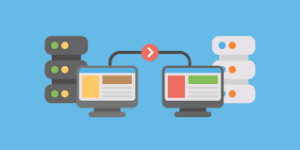
Web hosting is a service that allows individuals and organizations to publish their websites on the internet. Shared hosting and VPS hosting are popular options for website owners who want to keep their costs low, while a dedicated server provides complete control and resources to a single user. In this article, we will discuss how to migrate from shared or VPS hosting to a dedicated server.
Explanation of Shared Hosting, VPS Hosting, and Dedicated Hosting
Shared hosting is a hosting service where multiple websites are hosted on the same server, and they share the server resources like CPU, RAM, disk space, and bandwidth. The cost of shared hosting is low, but the resources are limited, and the performance may be affected by other websites on the same server.
VPS hosting is a virtual private server that allows users to have their own virtual server environment. It shares the physical server with other users, but each user has its own resources and operating system. VPS hosting offers more control and customization than shared hosting, and it can handle higher traffic volumes.
Dedicated hosting is a hosting service where the user has complete control over the server resources. The user rents an entire physical server that is not shared with anyone else. Dedicated hosting is suitable for high-traffic websites that require more resources and customization than shared or VPS hosting.
Reasons for Switching to a Dedicated Server

There are several reasons why website owners may consider switching to a dedicated server:
- Increased performance: Dedicated servers offer more resources and processing power than shared or VPS hosting, which results in faster website loading times and better performance.
- Customization: Dedicated servers allow users to install and configure software and applications according to their needs, providing complete control over the server environment.
- Security: Dedicated servers offer a higher level of security than shared or VPS hosting because the user has complete control over the server and can implement security measures according to their needs.
- High traffic websites: Dedicated servers are suitable for websites that receive high traffic volumes and require more resources to handle the traffic.
Planning the Migration
Migrating from shared or VPS hosting to a dedicated server requires careful planning and preparation. The following steps should be taken to ensure a smooth migration process:
- Assessing your website’s resource requirements: You need to determine the amount of resources required for your website to function optimally, including CPU, RAM, disk space, and bandwidth.
- Choosing a dedicated server provider: Choose a reliable hosting provider that offers a range of server configurations to choose from.
- Selecting a suitable server configuration: Choose a server configuration that meets your website’s resource requirements and budget.
- Setting up the necessary software and services: Install and configure the required software and services on your server, including the operating system, web server software, database software, and any other necessary software.
- Establishing a migration timeline and budget: Set a timeline for the migration process and allocate a budget for the server setup and migration.
Backing up Your Data
Before migrating to a dedicated server, it is essential to back up all your website’s data, including files, databases, and email accounts. Backing up your data ensures that you have a copy of your website in case of any unforeseen issues during the migration process.
Types of data to back up:
- Website files: All website files should be backed up, including HTML, CSS, JavaScript, images, and any other files.
- Databases: Back up all your databases, including MySQL, PostgreSQL, and any other databases used by your website.
- Email accounts: If you use email accounts associated with your domain, back up all your emails and settings.
Methods of backing up data:
- Manual backup: This involves copying files and databases manually to an external hard drive or cloud storage service.
- Automated backup: This involves using backup software to automate the backup process and schedule regular backups.
Verifying the integrity of your backups:
After backing up your data, it is essential to verify the integrity of the backups to ensure that the backup files are not corrupted. You can do this by restoring a backup file to a test environment and testing your website’s functionality and performance.
Transferring Your Website Files and Databases
Once you have backed up your data, the next step is to transfer your website files and databases to the new dedicated server. The following steps should be taken:
- Preparing for the transfer: Ensure that the new server is set up and ready to receive the website files and databases. You will need the login credentials for the new server, including the IP address, username, and password.
- Using FTP or SSH to transfer files: Use FTP or SSH to transfer your website files from the old server to the new server. FTP is a standard protocol for transferring files over the internet, while SSH is a secure protocol that provides secure file transfer.
- Exporting and importing databases: Export your databases from the old server and import them into the new server. You can use the command-line interface or a graphical user interface (GUI) tool to do this.
- Testing the transferred website: After transferring your website files and databases, test your website’s functionality and performance on the new server.
Updating Your Domain Name Settings
Once your website files and databases have been transferred to the new server, you need to update your domain name settings to point to the new server. The following steps should be taken:
- Updating your DNS records: Update your DNS records to point to the IP address of the new server. This can be done through your domain registrar’s control panel or through your DNS provider.
- Setting up domain redirects: Set up domain redirects to ensure that users who access your website through the old domain name are redirected to the new domain name.
- Minimizing downtime during the DNS propagation period: DNS propagation is the process of updating DNS records across the internet. During this period, your website may experience downtime. To minimize downtime, you can set a low TTL (time-to-live) value for your DNS records.
Configuring Your Server
After transferring your website files and databases and updating your domain name settings, the next step is to configure your server. The following steps should be taken:
- Installing and configuring your web server software: Install and configure your web server software, such as Apache or Nginx.
- Installing and configuring your database software: Install and configure your database software, such as MySQL or PostgreSQL.
- Installing and configuring any other necessary software: Install and configure any other necessary software, such as PHP or SSL.
Optimizing Your Server
To ensure optimal performance and security, your server needs to be optimized. The following steps should be taken:
- Fine-tuning your server’s performance: Fine-tune your server’s performance by optimizing your web server and database server settings.
- Implementing caching and optimization techniques: Implement caching and optimization techniques, such as content caching, opcode caching, and image optimization.
- Securing your server against threats and attacks: Implement security measures, such as firewall, SSL, and malware protection, to secure your server against threats and attacks.
Testing Your Website and Monitoring Your Server
After configuring and optimizing your server, the next step is to test your website’s functionality and performance and monitor your server’s resource usage and performance. The following steps should be taken:
- Testing your website’s functionality and performance: Test your website’s functionality and performance to ensure that everything is working correctly.
- Monitoring your server’s resource usage and performance: Monitor your server’s resource usage and performance to ensure that it is running optimally and that there are no issues.
- Troubleshooting common issues: Troubleshoot common issues that may arise, such as website errors or server crashes.
Conclusion
Migrating from a shared or VPS hosting to a dedicated server can be a daunting task, but with proper planning and execution, it can be done smoothly and efficiently. By assessing your website’s resource requirements, choosing a dedicated server provider, backing up your data, transferring your website files and databases, updating your domain name settings, configuring and optimizing your server, testing your website and monitoring your server, you can ensure a successful migration.
It is essential to take your time and ensure that each step is done correctly to avoid any issues that could cause downtime or loss of data. Remember to monitor your server’s performance regularly and perform maintenance tasks, such as updates and backups, to keep your website running optimally.
Final tips and recommendations:
- Choose a dedicated server provider that offers good customer support, reliable uptime, and fast network speeds.
- Opt for a managed dedicated server if you do not have the technical expertise to manage the server yourself.
- Use backup software to automate the backup process and schedule regular backups.
- Test your website’s functionality and performance after migrating to the new server.
- Monitor your server’s resource usage and performance regularly to detect any issues early.